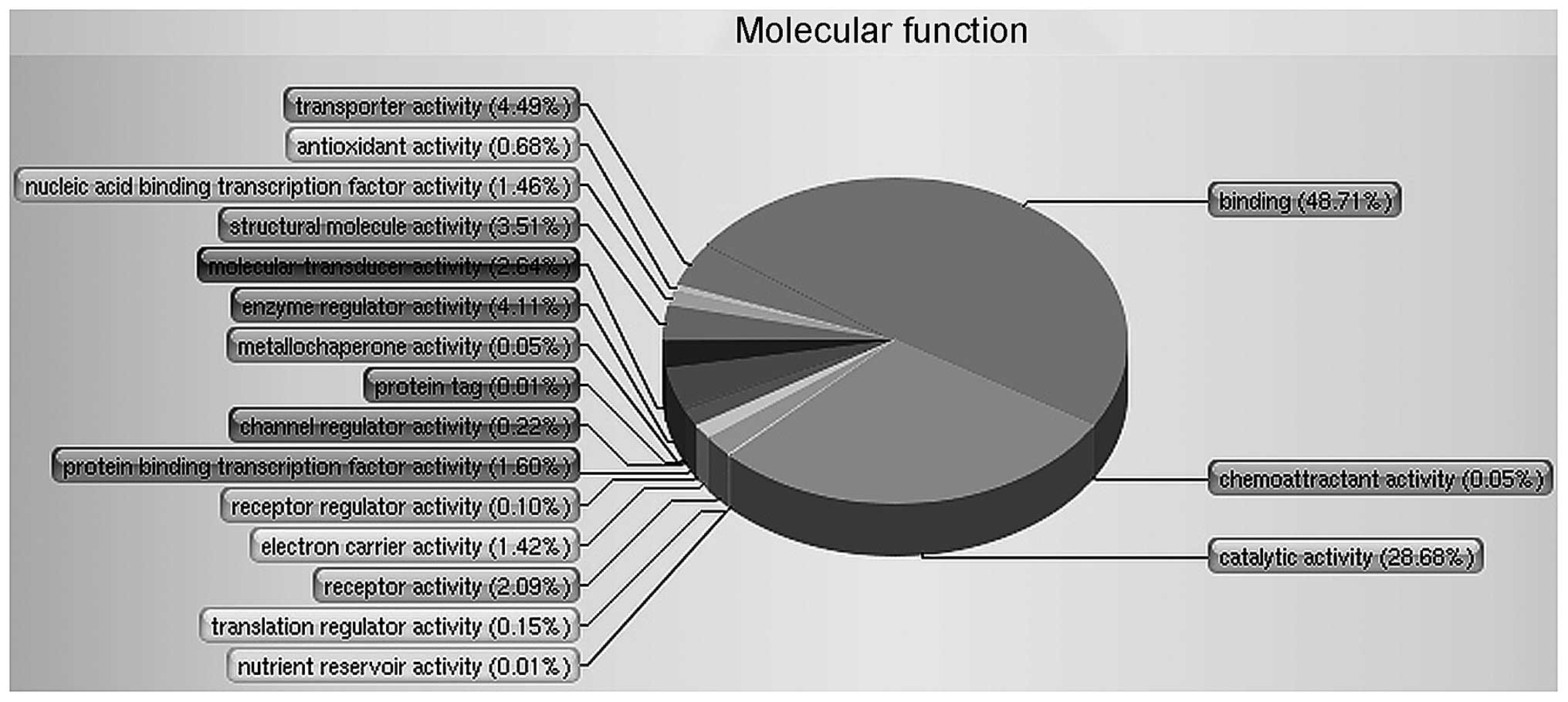|
1
|
Roussos C and Koutsoukou A: Respiratory
failure. Eur Respir J Suppl. 47:3s–14s. 2003. View Article : Google Scholar : PubMed/NCBI
|
|
2
|
Roussos C and Macklem PT: The respiratory
muscles. N Engl J Med. 307:786–797. 1982. View Article : Google Scholar : PubMed/NCBI
|
|
3
|
Burt CC and Arrowsmith JE: Respiratory
failure. Surgery. 27:475–479. 2009.
|
|
4
|
Chang X, Cui Y, Zong M, Zhao Y, Yan X,
Chen Y and Han J: Identification of proteins with increased
expression in rheumatoid arthritis synovial tissues. J Rheumatol.
36:872–880. 2009. View Article : Google Scholar : PubMed/NCBI
|
|
5
|
Gibson DS, Blelock S, Curry J, Finnegan S,
Healy A, Scaife C, McAllister C, Pennington S, Dunn M and Rooney M:
Comparative analysis of synovial fluid and plasma proteomes in
juvenile arthritis - proteomic patterns of joint inflammation in
early stage disease. J Proteomics. 72:656–676. 2009. View Article : Google Scholar : PubMed/NCBI
|
|
6
|
Dai Y, Hu C, Huang Y, Huang H, Liu J and
Lv T: A proteomic study of peripheral blood mononuclear cells in
systemic lupus erythematosus. Lupus. 17:799–804. 2008. View Article : Google Scholar : PubMed/NCBI
|
|
7
|
DeSouza LV, Grigull J, Ghanny S, Dubé V,
Romaschin AD, Colgan TJ and Siu KW: Endometrial carcinoma biomarker
discovery and verification using differentially tagged clinical
samples with multidimensional liquid chromatography and tandem mass
spectrometry. Mol Cell Proteomics. 6:1170–1182. 2007. View Article : Google Scholar : PubMed/NCBI
|
|
8
|
Al Badaai Y, DiFalco MR, Tewfik MA and
Samaha M: Quantitative proteomics of nasal mucus in chronic
sinusitis with nasal polyposis. J Otolaryngol Head Neck Surg.
38:381–389. 2009.PubMed/NCBI
|
|
9
|
Zhou L, Beuerman RW, Chan CM, Zhao SZ, Li
XR, Yang H, Tong L, Liu S, Stern ME and Tan D: Identification of
tear fluid biomarkers in dry eye syndrome using iTRAQ quantitative
proteomics. J Proteome Res. 8:4889–4905. 2009. View Article : Google Scholar : PubMed/NCBI
|
|
10
|
Hergenroeder G, Redell JB, Moore AN,
Dubinsky WP, Funk RT, Crommett J, Clifton GL, Levine R, Valadka A
and Dash PK: Identification of serum biomarkers in brain-injured
adults: Potential for predicting elevated intracranial pressure. J
Neurotrauma. 25:79–93. 2008. View Article : Google Scholar : PubMed/NCBI
|
|
11
|
Bantscheff M, Schirle M, Sweetman G, Rick
J and Kuster B: Quantitative mass spectrometry in proteomics: A
critical review. Anal Bioanal Chem. 389:1017–1031. 2007. View Article : Google Scholar : PubMed/NCBI
|
|
12
|
Li X, Hu B, Ding J and Chen H: Rapid
characterization of complex viscous samples at molecular levels by
neutral desorption extractive electrospray ionization mass
spectrometry. Nat Protoc. 6:1010–1025. 2011. View Article : Google Scholar : PubMed/NCBI
|
|
13
|
Couttas TA, Raftery MJ, Erce MA and
Wilkins MR: Monitoring cytoplasmic protein complexes with blue
native gel electrophoresis and stable isotope labelling with amino
acids in cell culture: Analysis of changes in the 20S proteasome.
Electrophoresis. 32:1819–1823. 2011. View Article : Google Scholar : PubMed/NCBI
|
|
14
|
Albaum SP, Hahne H, Otto A, Haußmann U,
Becher D, Poetsch A, Goesmann A and Nattkemper TW: A guide through
the computational analysis of isotope-labeled mass
spectrometry-based quantitative proteomics data: An application
study. Proteome Sci. 9:302011. View Article : Google Scholar : PubMed/NCBI
|
|
15
|
Hergenroeder G, Redell JB, Moore AN,
Dubinsky WP, Funk RT, Crommett J, Clifton GL, Levine R, Valadka A
and Dash PK: Identification of serum biomarkers in brain-injured
adults: Potential for predicting elevated intracranial pressure. J
Neurotrauma. 25:79–93. 2008. View Article : Google Scholar : PubMed/NCBI
|
|
16
|
Matta A, DeSouza LV, Shukla NK, Gupta SD,
Ralhan R and Siu KW: Prognostic significance of head-and-neck
cancer biomarkers previously discovered and identified using
iTRAQ-labeling and multidimensional liquid chromatography-tandem
mass spectrometry. J Proteome Res. 7:2078–2087. 2008. View Article : Google Scholar : PubMed/NCBI
|
|
17
|
Nagase T, Kikuno R, Ishikawa K, Hirosawa M
and Ohara O: Prediction of the coding sequences of unidentified
human genes. XVII. The complete sequences of 100 new cDNA clones
from brain which code for large proteins in vitro. DNA Res.
7:143–150. 2000. View Article : Google Scholar : PubMed/NCBI
|
|
18
|
Crabtree GR and Kant JA: Organization of
the rat gamma-fibrinogen gene: Alternative mRNA splice patterns
produce the gamma A and gamma B (gamma ') chains of fibrinogen.
Cell. 31:159–166. 1982. View Article : Google Scholar : PubMed/NCBI
|
|
19
|
Fornace AJ Jr, Cummings DE, Comeau CM,
Kant JA and Crabtree GR: Structure of the human gamma-fibrinogen
gene. Alternate mRNA splicing near the 3′ end of the gene produces
gamma A and gamma B forms of gamma-fibrinogen. J Biol Chem.
259:12826–12830. 1984.PubMed/NCBI
|
|
20
|
Song YJ, Zhou ZH, Liu YK, Rao SM and Huang
YJ: Prothrombotic state in senile patients with acute exacerbations
of chronic obstructive pulmonary disease combined with respiratory
failure. Exp Ther Med. 5:1184–1188. 2013.PubMed/NCBI
|
|
21
|
Xu J, Gao XP, Ramchandran R, Zhao YY,
Vogel SM and Malik AB: Nonmuscle myosin light-chain kinase mediates
neutrophil transmigration in sepsis-induced lung inflammation by
activating beta2 integrins. Nat Immunol. 9:880–886. 2008.
View Article : Google Scholar : PubMed/NCBI
|










